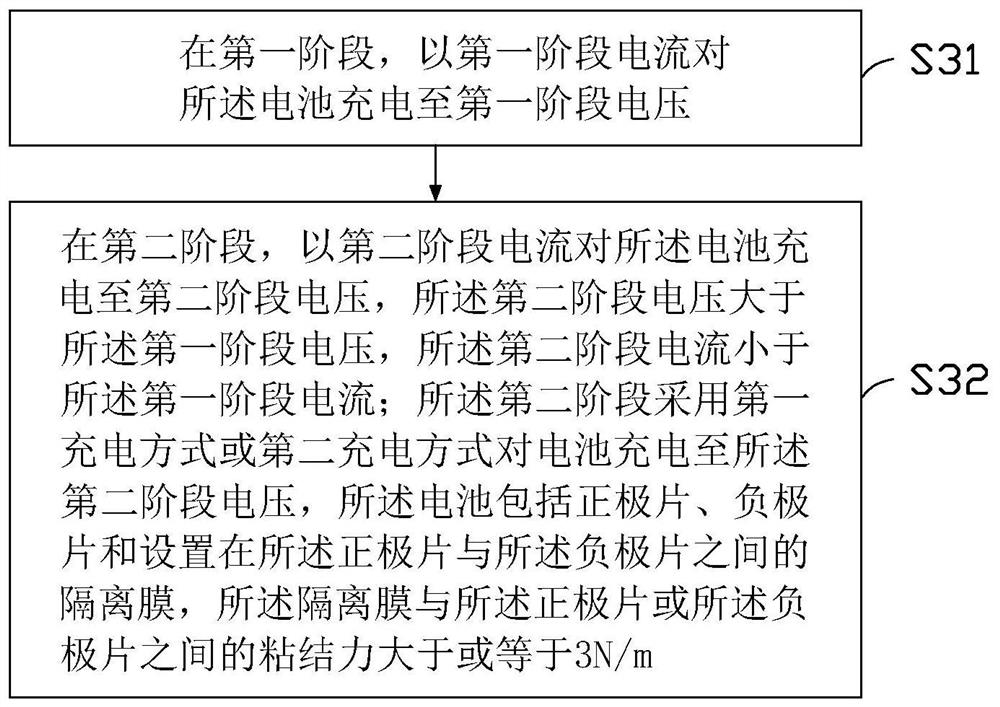Method for improving battery cycle performance and electronic device
A battery cycle and battery charging technology, applied in battery circuit devices, circuit devices, secondary battery charging/discharging, etc., can solve the problems of unsatisfactory cycle capacity retention rate, aggravated cathode structure damage, and battery performance deterioration, etc., to improve The effect of high temperature cycling performance, reducing the interfacial reaction rate, and improving the cycling performance
- Summary
- Abstract
- Description
- Claims
- Application Information
AI Technical Summary
Problems solved by technology
Method used
Image
Examples
Embodiment 23
[0114] Embodiment 23 adopts the new charging method 2 in this application, and the specific process is as follows:
[0115] The ambient temperature is 55°C;
[0116] Step 1: Charge the battery to 4.4V with a constant current of 0.7C;
[0117] Step 2: Charge the battery to 0.4C with a constant voltage of 4.35V;
[0118] Step 3: Charge the battery to 0.13C with a constant voltage of 4.45V;
[0119] Step 4: Let the battery stand for 5 minutes;
[0120] Step 5: Discharge the battery to 3.0V with a constant current of 0.5C;
[0121] Step 6: Let the battery stand for 5 minutes;
[0122] Step 7: Cycle the above steps 1 to 6 500 times.
Embodiment 24
[0123] Embodiment 24 adopts the new charging method 3 in this application, and the specific process is as follows:
[0124] The ambient temperature is 55°C;
[0125] Step 1: Charge the battery to 4.4V with a constant current of 0.7C (2.1A);
[0126] Step 2: Charge the battery to 4.45V with a constant power of 7W;
[0127] Step 3: Charge the battery to 4.55V with a constant power of 5.5W;
[0128] Step 4: Let the battery stand for 5 minutes;
[0129] Step 5: Discharge the battery to 3.0V with a constant current of 0.5C;
[0130] Step 6: Let the battery stand for 5 minutes;
[0131] Step 7: Cycle the above steps 1 to 6 500 times.
Embodiment 25
[0132] Embodiment 25 adopts the new charging method 4 in this application, and the specific process is as follows:
[0133] The ambient temperature is 55°C;
[0134] Step 1: Charge the battery to 4.4V with a constant current of 0.7C;
[0135] Step 2: Charge the battery to 0.5C with a constant voltage of 4.4V;
[0136] Step 3: Charge the battery to 4.45V with a constant current of 0.5C;
[0137] Step 4: Charge the battery to 0.3C with a constant voltage of 4.45V;
[0138] Step 5: Let the battery stand for 5 minutes;
[0139] Step 6: Discharge the battery to 3.0V with a constant current of 0.5C;
[0140] Step 7: Let the battery stand for 5 minutes;
[0141] Step 8: Cycle the above steps 1 to 7 for 500 circles.
PUM
| Property | Measurement | Unit |
|---|---|---|
| particle diameter | aaaaa | aaaaa |
| particle diameter | aaaaa | aaaaa |
| cover factor | aaaaa | aaaaa |
Abstract
Description
Claims
Application Information
 Login to View More
Login to View More - R&D
- Intellectual Property
- Life Sciences
- Materials
- Tech Scout
- Unparalleled Data Quality
- Higher Quality Content
- 60% Fewer Hallucinations
Browse by: Latest US Patents, China's latest patents, Technical Efficacy Thesaurus, Application Domain, Technology Topic, Popular Technical Reports.
© 2025 PatSnap. All rights reserved.Legal|Privacy policy|Modern Slavery Act Transparency Statement|Sitemap|About US| Contact US: help@patsnap.com



